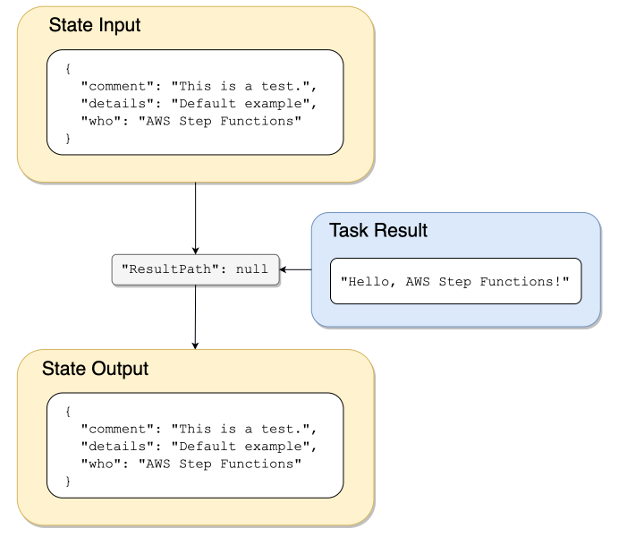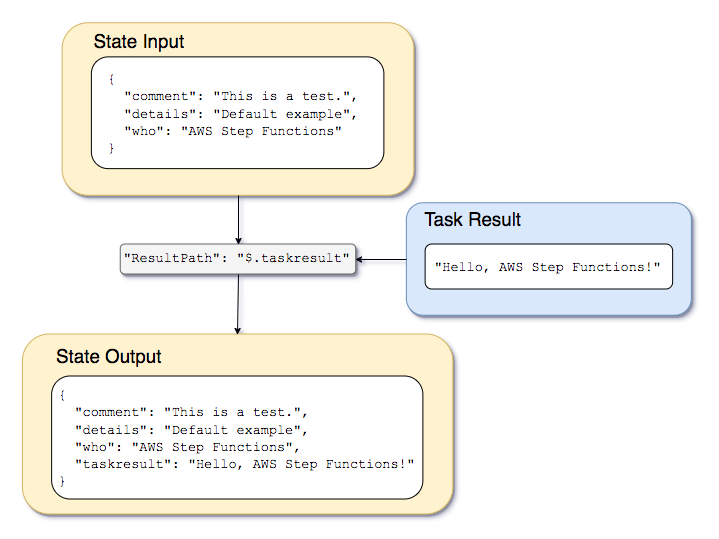ResultPath
The output of a state can be a copy of its input, the result it produces (for example,
output from a Task state’s Lambda function), or a combination of its input and
result. Use ResultPath to control which combination of these is passed to the state
output.
The following state types can generate a result and can include
ResultPath:
Use ResultPath to combine a task result with task input, or to select one of
these. The path you provide to ResultPath controls what information passes to the
output.
Note
ResultPath is limited to using reference paths, which limit scope
so that it can identify only a single node in JSON. See Reference Paths in the Amazon States Language.
These examples are based on the state machine and Lambda function described in the Creating a Step Functions state machine that uses Lambda tutorial. Work through that tutorial
and test different outputs by trying various paths in a ResultPath field.
Use ResultPath to:
Tip
Use the
data flow simulator in the Step Functions console
Use ResultPath to Replace the Input with the Result
If you don't specify a ResultPath, the default behavior is as if you had
specified "ResultPath": "$". Because this tells the state to replace the entire
input with the result, the state input is completely replaced by the result coming from the
task result.
The following diagram shows how ResultPath can completely replace the input
with the result of the task.

Use the state machine and Lambda function described in Creating a Step Functions state machine that uses Lambda, and change the
service integration type to AWS SDK integration for the Lambda function. To do this, specify the Lambda function Amazon Resource Name (ARN) in the
Resource field of the Task state as shown in the following example. Using AWS SDK integration ensures that the Task state result only contains the
Lambda function output without any metadata.
{
"StartAt":"CallFunction",
"States":{
"CallFunction": {
"Type":"Task",
"Resource":"arn:aws:lambda:us-east-2:123456789012:function:HelloFunction",
"End": true
}
}
} Then, pass the following input:
{ "comment": "This is a test of the input and output of a Task state.", "details": "Default example", "who": "AWS Step Functions" }
The Lambda function provides the following result.
"Hello, AWS Step Functions!"
Tip
You can view this result on the Step Functions console
If ResultPath isn't specified in the state, or if "ResultPath":
"$" is set, the input of the state is replaced by the result of the Lambda function,
and the output of the state is the following.
"Hello, AWS Step Functions!"
Note
ResultPath is used to include content from the result with the input,
before passing it to the output. But, if ResultPath isn't specified, the
default is to replace the entire input.
Discard the Result and Keep the Original Input
If you set ResultPath to null, it will pass the original input
to the output. Using "ResultPath": null, the state's input payload will be copied
directly to the output, with no regard for the result.
The following diagram shows how a null ResultPath will copy the input
directly to the output.

Use ResultPath to Include the Result with the Input
The following diagram shows how ResultPath can include the result with the
input.

Using the state machine and Lambda function described in the Creating a Step Functions state machine that uses Lambda tutorial, we could pass the following input.
{ "comment": "This is a test of the input and output of a Task state.", "details": "Default example", "who": "AWS Step Functions" }
The result of the Lambda function is the following.
"Hello, AWS Step Functions!"
To preserve the input, insert the result of the Lambda function, and then pass the combined
JSON to the next state, we could set ResultPath to the following.
"ResultPath": "$.taskresult"
This includes the result of the Lambda function with the original input.
{ "comment": "This is a test of input and output of a Task state.", "details": "Default behavior example", "who": "AWS Step Functions", "taskresult": "Hello, AWS Step Functions!" }
The output of the Lambda function is appended to the original input as a value for
taskresult. The input, including the newly inserted value, is passed to the
next state.
You can also insert the result into a child node of the input. Set the
ResultPath to the following.
"ResultPath": "$.strings.lambdaresult"
Start an execution using the following input.
{ "comment": "An input comment.", "strings": { "string1": "foo", "string2": "bar", "string3": "baz" }, "who": "AWS Step Functions" }
The result of the Lambda function is inserted as a child of the strings node
in the input.
{ "comment": "An input comment.", "strings": { "string1": "foo", "string2": "bar", "string3": "baz", "lambdaresult": "Hello, AWS Step Functions!" }, "who": "AWS Step Functions" }
The state output now includes the original input JSON with the result as a child node.
Use ResultPath to Update a Node in the Input with the Result
The following diagram shows how ResultPath can update the value of existing
JSON nodes in the input with values from the task result.

Using the example of the state machine and Lambda function described in the Creating a Step Functions state machine that uses Lambda tutorial, we could pass the following input.
{ "comment": "This is a test of the input and output of a Task state.", "details": "Default example", "who": "AWS Step Functions" }
The result of the Lambda function is the following.
Hello, AWS Step Functions!
Instead of preserving the input and inserting the result as a new node in the JSON, we can overwrite an existing node.
For example, just as omitting or setting "ResultPath": "$" overwrites the
entire node, you can specify an individual node to overwrite with the result.
"ResultPath": "$.comment"
Because the comment node already exists in the state input, setting
ResultPath to "$.comment" replaces that node in the input with the
result of the Lambda function. Without further filtering by OutputPath, the
following is passed to the output.
{ "comment": "Hello, AWS Step Functions!", "details": "Default behavior example", "who": "AWS Step Functions", }
The value for the comment node, "This is a test of the input and output
of a Task state.", is replaced by the result of the Lambda function: "Hello, AWS
Step Functions!" in the state output.
Use ResultPath to Include Both Error and Input
in a Catch
The Handling error conditions using a Step Functions
state machine tutorial shows how to use a state machine to
catch an error. In some cases, you might want to preserve the original input with the error.
Use ResultPath in a Catch to include the error with the original
input, instead of replacing it.
"Catch": [{ "ErrorEquals": ["States.ALL"], "Next": "NextTask", "ResultPath": "$.error" }]
If the previous Catch statement catches an error, it includes the result in
an error node within the state input. For example, with the following
input:
{"foo": "bar"}
The state output when catching an error is the following.
{ "foo": "bar", "error": { "Error": "Error here" } }
For more information about error handling, see the following: